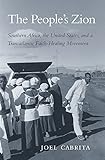The People’s Zion : Southern Africa, the United States, and a Transatlantic Faith-Healing Movement / Joel Cabrita.
Material type: TextPublisher: Cambridge, MA : Harvard University Press, [2018]Copyright date: ©2018Description: 1 online resource (340 p.) : 16 halftones, 2 mapsContent type:
TextPublisher: Cambridge, MA : Harvard University Press, [2018]Copyright date: ©2018Description: 1 online resource (340 p.) : 16 halftones, 2 mapsContent type: - 9780674985780
- online - DeGruyter
| Item type | Current library | Call number | URL | Status | Notes | Barcode | |
|---|---|---|---|---|---|---|---|
 eBook
eBook
|
Biblioteca "Angelicum" Pont. Univ. S.Tommaso d'Aquino Nuvola online | online - DeGruyter (Browse shelf(Opens below)) | Online access | Not for loan (Accesso limitato) | Accesso per gli utenti autorizzati / Access for authorized users | (dgr)9780674985780 |
Browsing Biblioteca "Angelicum" Pont. Univ. S.Tommaso d'Aquino shelves, Shelving location: Nuvola online Close shelf browser (Hides shelf browser)

|

|

|

|

|

|

|
||
| online - DeGruyter The Republic of Arabic Letters : Islam and the European Enlightenment / | online - DeGruyter A World of Empires : The Russian Voyage of the Frigate Pallada / | online - DeGruyter Christian : The Politics of a Word in America / | online - DeGruyter The People’s Zion : Southern Africa, the United States, and a Transatlantic Faith-Healing Movement / | online - DeGruyter Colonial al-Andalus : Spain and the Making of Modern Moroccan Culture / | online - DeGruyter The Law of Blood : Thinking and Acting as a Nazi / | online - DeGruyter Catholic Modern : The Challenge of Totalitarianism and the Remaking of the Church / |
Frontmatter -- Contents -- Introduction: The People’s Zion -- 1. Temperance, Divine Healing, and Urban Reform in Nineteenth-Century Australia -- 2. Christian Cosmopolitanism and Zion City in the American Midwest -- 3. Unity and Division in Early Twentieth-Century Johannesburg and in Transatlantic Zion -- 4. Zion’s Egalitarian Promises in the Transvaal and Orange River Colonies, South Africa -- 5. Sectarian Creativity and Populist Prophets in Interwar Johannesburg -- 6. Cosmopolitanism, Ethnicity, and Migrant Labor Networks in Southern African Zion -- 7. Youthful Reformers and the Politics of Bible Schools in the Kingdom of Swaziland -- Afterword: Zion and Pentecost -- APPENDIX 1. INTERVIEWS -- APPENDIX 2. LIST OF PRIMARY SOURCES -- ABBREVIATIONS -- NOTES -- ACKNOWLEDGMENTS -- INDEX
restricted access online access with authorization star
http://purl.org/coar/access_right/c_16ec
In The People’s Zion, Joel Cabrita tells the transatlantic story of Southern Africa’s largest popular religious movement, Zionism. It began in Zion City, a utopian community established in 1900 just north of Chicago. The Zionist church, which promoted faith healing, drew tens of thousands of marginalized Americans from across racial and class divides. It also sent missionaries abroad, particularly to Southern Africa, where its uplifting spiritualism and pan-racialism resonated with urban working-class whites and blacks. Circulated throughout Southern Africa by Zion City’s missionaries and literature, Zionism thrived among white and black workers drawn to Johannesburg by the discovery of gold. As in Chicago, these early devotees of faith healing hoped for a color-blind society in which they could acquire equal status and purpose amid demoralizing social and economic circumstances. Defying segregation and later apartheid, black and white Zionists formed a uniquely cosmopolitan community that played a key role in remaking the racial politics of modern Southern Africa. Connecting cities, regions, and societies usually considered in isolation, Cabrita shows how Zionists on either side of the Atlantic used the democratic resources of evangelical Christianity to stake out a place of belonging within rapidly-changing societies. In doing so, they laid claim to nothing less than the Kingdom of God. Today, the number of American Zionists is small, but thousands of independent Zionist churches counting millions of members still dot the Southern African landscape.
Mode of access: Internet via World Wide Web.
In English.
Description based on online resource; title from PDF title page (publisher's Web site, viewed 01. Dez 2022)


